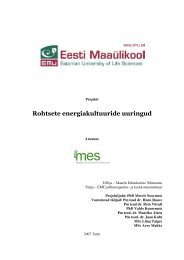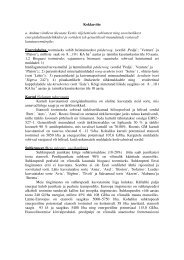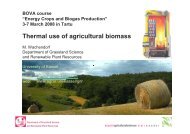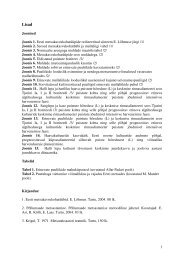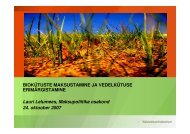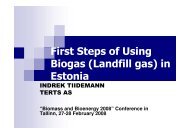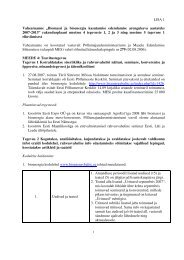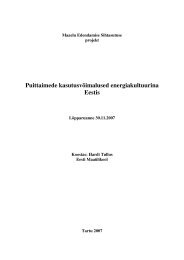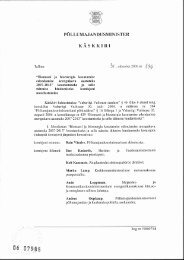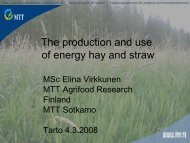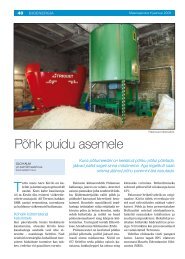Põllumajandusministeeriumi ja Maaelu ... - bioenergybaltic
Põllumajandusministeeriumi ja Maaelu ... - bioenergybaltic
Põllumajandusministeeriumi ja Maaelu ... - bioenergybaltic
Create successful ePaper yourself
Turn your PDF publications into a flip-book with our unique Google optimized e-Paper software.
Estonia while the changing waste content must be taken into consideration in relation to the<br />
implementation of requirements for waste sorting.<br />
When processing the agricultural biomass and upgrading it to fuel, a lot of waste products with<br />
specific properties are generated the utilization of which could also be the combustion and<br />
gaining energy. However, the respective technologies are not available:<br />
• The rapeseed cake is a by-product of the rapeseed oil industry. In the Painküla plant<br />
48,000 tons of the cake is produced annually and partly used as a fodder. In case of<br />
rapeseed with the high oil content, the cake cannot be used as a fodder;<br />
• annually ca 11,500 tons of glycerol generated from the biodiesel production in the<br />
Paldiski Biodiesel Plant. With the growth of biodiesel capacities, there will be no<br />
market for bioglycerol.<br />
Principally rapeseed cake can be pelletized too and therefore in the future work the potentials<br />
both for the direct combustion of cake and pellets production and combustion should be<br />
investigated. Problems related to the expedient use of glycerol residues have become acute in<br />
all countries where the production of biodiesel has started on a wide scale. Therefore it will be<br />
reasonable to study the options for glycerol combustion within the framework of some<br />
international project supported by the European Union.<br />
Potential for biogas production – acceptable technological solutions, capacities, locations,<br />
prerequisites for developing a network<br />
The water and air pollution created by the household, industrial and agricultural waste has<br />
become one of the biggest problems all over the world. For eliminating this problem new<br />
effective and inexpensive waste treatment methods are being looked for. One of such<br />
technologies is the anaerobic treatment of organic waste and biogas production within this<br />
process. So the pollution load is not only reduced, but it also allows the production of energy<br />
(heat, electricity), motor fuel and fertilizers.<br />
The following biodegradable materials (biomass and organic waste) can be and are being used<br />
for biogas production in many places around the world:<br />
7. Household waste (its biodegradable (organic) part);<br />
8. Industrial biodegradable production waste and residues;<br />
9. Biodegradable agricultural waste and residues from the cattle raising and poultry farming;<br />
10. Sewage sediments and sludges;<br />
11. herbaceous biomass (either naturally growing herbs or the so-called specially grown and<br />
ensilaged energy crops);<br />
12. landfills of settlements (the so-called landfill gas is collected, which has the properties<br />
similar to the biogas produced from the above sources in the anaerobic fermentation<br />
process).<br />
The Estonian biogas resources presented here have indicative character and have been<br />
predominantly calculated based on the coefficients given in references and on the amount of<br />
separate raw material resources. The results are given by counties. Before building a biogas<br />
plant, in any case a feasibility analysis has to be made (the analysis of available raw material,<br />
technical, economic, environmental social and risk analyses) and business plan prepared<br />
considering also the available state-subsidized schemes. The decision where and with what<br />
capacity a biogas fired CHP plant can be built could be made only based on these results.<br />
Therefore the options for biogas production have not been analysed on the basis of certain<br />
company, because it is not known who, where and when and with what production capacity<br />
would want to build biogas based plants (BGP).<br />
102




